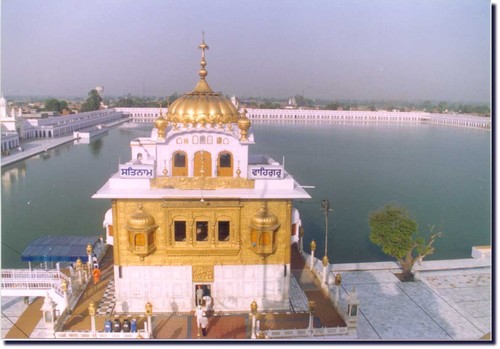
Gurdwara Sri Tarn Taran Sahib
Gurdwara Sri Tarn Taran Sahib is a gurdwara established by the fifth guru, Guru Arjan Dev, in the city of Tarn Taran Sahib, Punjab, India. The site has the distinction of having the largest Sarovar (water pond) of all the Gurdwaras. It is famous for the monthly gathering of pilgrims on the day of Amavas (a no-moon night). It is near Harmandir Sahib, Amritsar.
Sikh Gurus Period 1469-1708
Guru Arjan Dev Ji, the Fifth Sikh Master, founded Tarn Taran Sahib in the year 1590, in the Land of Panjab (Majha Region). At that time, the digging of the lake tank started. When the tank was completed, it was the biggest and largest sarovar lake in the whole of Panjab. The foundation stone of Darbar Sahib was laid by Dhan Dhan Baba Buddha Ji, a famous Sikh saint (1506–1631). Later, the Sixth Sikh Master, Guru Hargobind Sahib, came to the gurdwara and stayed for some time. Guru Tegh Bahadur, the ninth Sikh Master, also visited Tarn Taran Sahib and preached to the Sikh sangat.
Sikh Misl Period 1707-1799
Baba Deep Singh Shaheed at Tarn Taran Sahib made a mark on the ground, and he asked the Sikhs if they were ready to die fighting against the enemies before entering into war against the Mughal Empire in 1757.
In 1768 Sardar Budh Singh Virk of Singhpuria Misl and Maharaja Jassa Singh Ramgarhia of Ramgarhia Misl joined hands to rebuild the Darbar Sahib Tarn Taran. Which then was in a shape of a traditional mud building. ”Waheguru ji ka Khalsa Waheguru ji ki Fateh”.
Sher-e-Panjab period 1799-1849
Later Maharaja Ranjit Singh Sher-e-Panjab (1799–1839), who visited Darbar Sahib Tarn Taran from 1802-1837, reconstructed the present Darbar Sahib Tarn Taran in 1836-1837 and also completed the work of the Parikarma which had been left unfinished by the two Sardars Singhpuria Misl and Ramgarhia Misl. Sher-e-Panjab gold-plated the Darbar Sahib Tarn Taran, as he did with the Harmandir Sahib at Amritsar. Artisans were called in by the Maharaja of Panjab Kingdom to decorate the inside of Darbar Sahib Tarn Taran.
Sher-e-Panjab built 17 massive gate entrances in Tarn Taran in which elephants could easily go through. When Maharaja Nau Nihal Singh, the grandson of Sher-e-Panjab, came to Tarn Taran, he built a minara (tower) at the end of the sarovar. Only one was completed, which can be seen while walking to Darbar Sahib. Three others were planned on each end of the sarovar, but were not constructed due to the death of Maharaja Nau Nihal Singh and also because of the two Anglo-Sikh Wars (1845–1849) against the British.
British Period 1849-1947
In 1877, Bhai Harsa Singh, a granthi of Darbar Sahib, Tarn Taran, was the first teacher, of the Singh Sabha movement, which came into existence in 1873, to protect the Sikhs of Punjab, against the Arya Samaj, Christian Missionaries, who were at that time trying the best to convert the Sikhs, but found it hard to make there ways into the Sikh population.
In 1883, Raja Raghubir Singh (1832-1887), the Sikh Chieftain of Jind Princely State, had a channel dug, from the sarovar,to bring in new water, to keep the tank beautified. The channel was latter paved by Sant Gurmukh Singh (1849-1947), of Patiala from 1927-28. During 1923-28, the Sarovar at Tarn Taran was desilted and lined.
During the British Rule (1849–1947), Sardar Arur Singh Shergill (1865–1926) was made the manager of Tarn Taran Sahib Gurdwara from 1907-1920, by the British, to keep the Sikh shrine out of direct Sikh Control. In 1905 an earthquake damaged the Lotus Dome of Darbar Sahib Tarn Taran, but soon after it was rebuilt. The Sikhs of Punjab fought and sacrificed to gain independence from the British rulers. In 1921 greedy priests divided the income of the Gurdwara among themselves. It was in 1921 that the Sikhs decided to free Tarn Taran Sahib. Seventeen Sikhs got injured at Tarn Taran. Two Sikhs attained martyrdom - Sardar Hazara Singh of Village Aladinpur District Amritsar and Sardar Hukam Singh of Village Wasoo Kot District Gurdaspur.
They were the first martyrs of the Gurdwara reform movement. On arrival of more squads on 26 January, the priests handed over the management of the Gurdwara to the Prabhandak Committee. This martyrdom was known as Saka Tarn Taran.
After independence Period 1947-Present Day
Since the partition of 1947, more work (kar Seva) has been done on Darbar Sahib Tarn Taran. The first work was in 1970, when the Old Bungas Towers of Sikh chieftains were demolished to construct a big complex. In all four corners of Darbar Sahib, the Holy Tank (Sarovar) was cleaned by Sikhs. In the early 1980s, a big hall was built to replace many Old Sikh period buildings. In 2005 the whole of Darbar Sahib was renovated. It was plated in new gold, and inside the Darbar Sahib new work was done. New marble was inlaid; a big complex was built; and more buildings were added around the complex. This Karsewa was done by Baba Jagtar Singh ji Karsewa Tarn Taran Wale.
